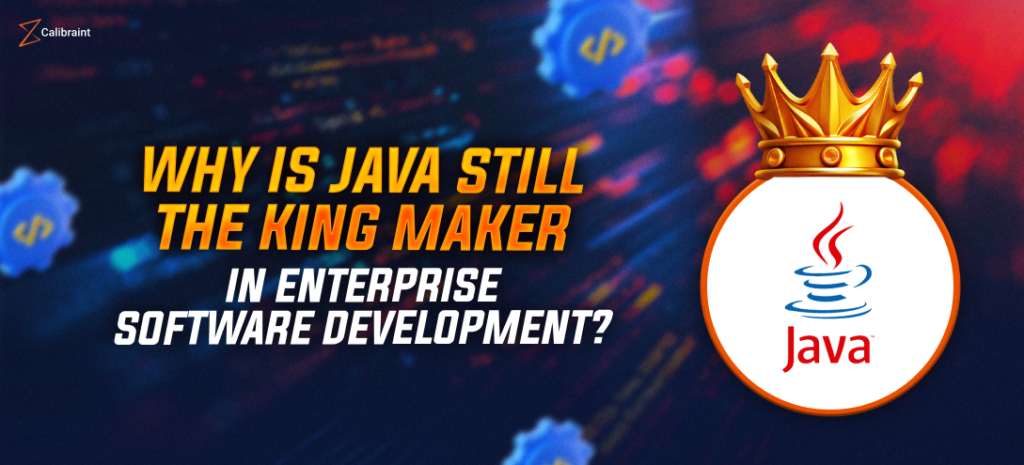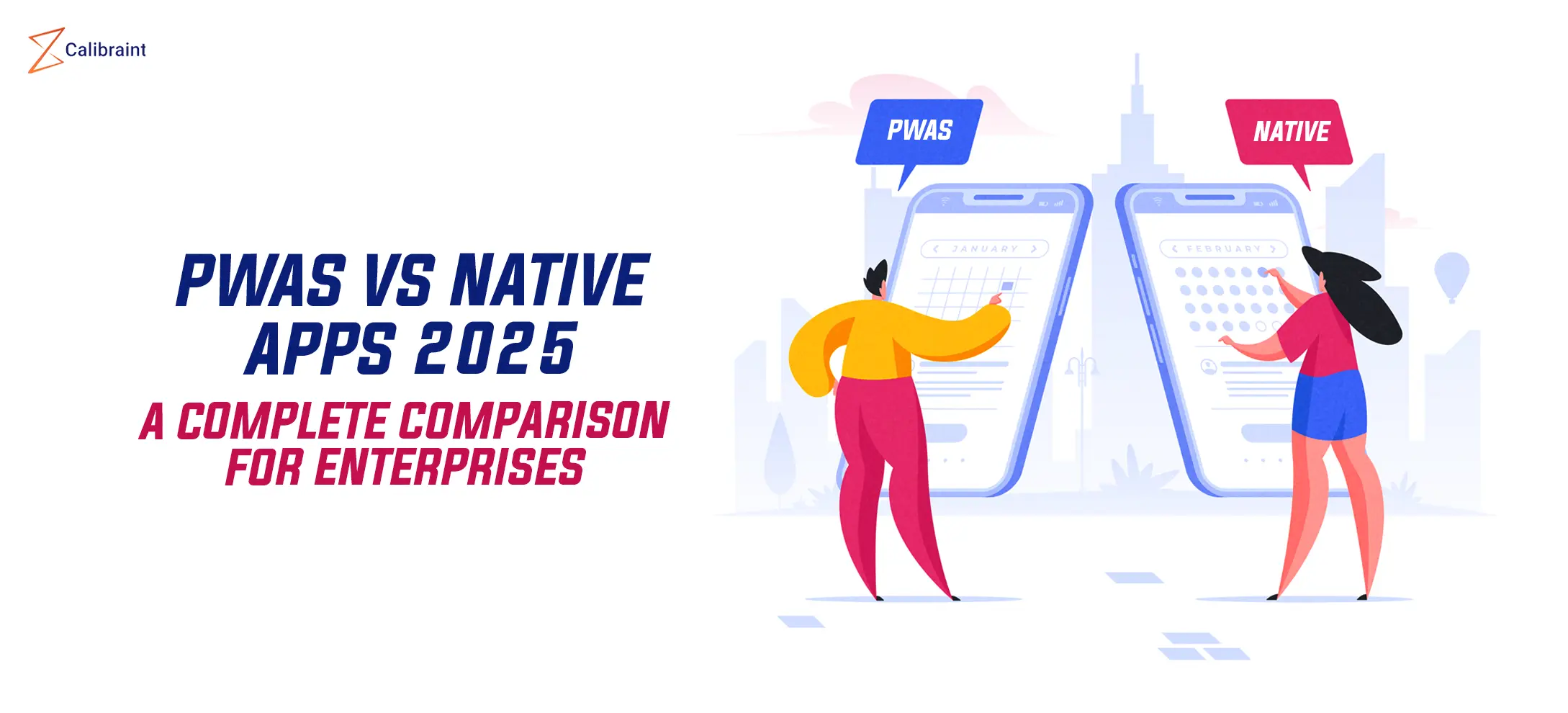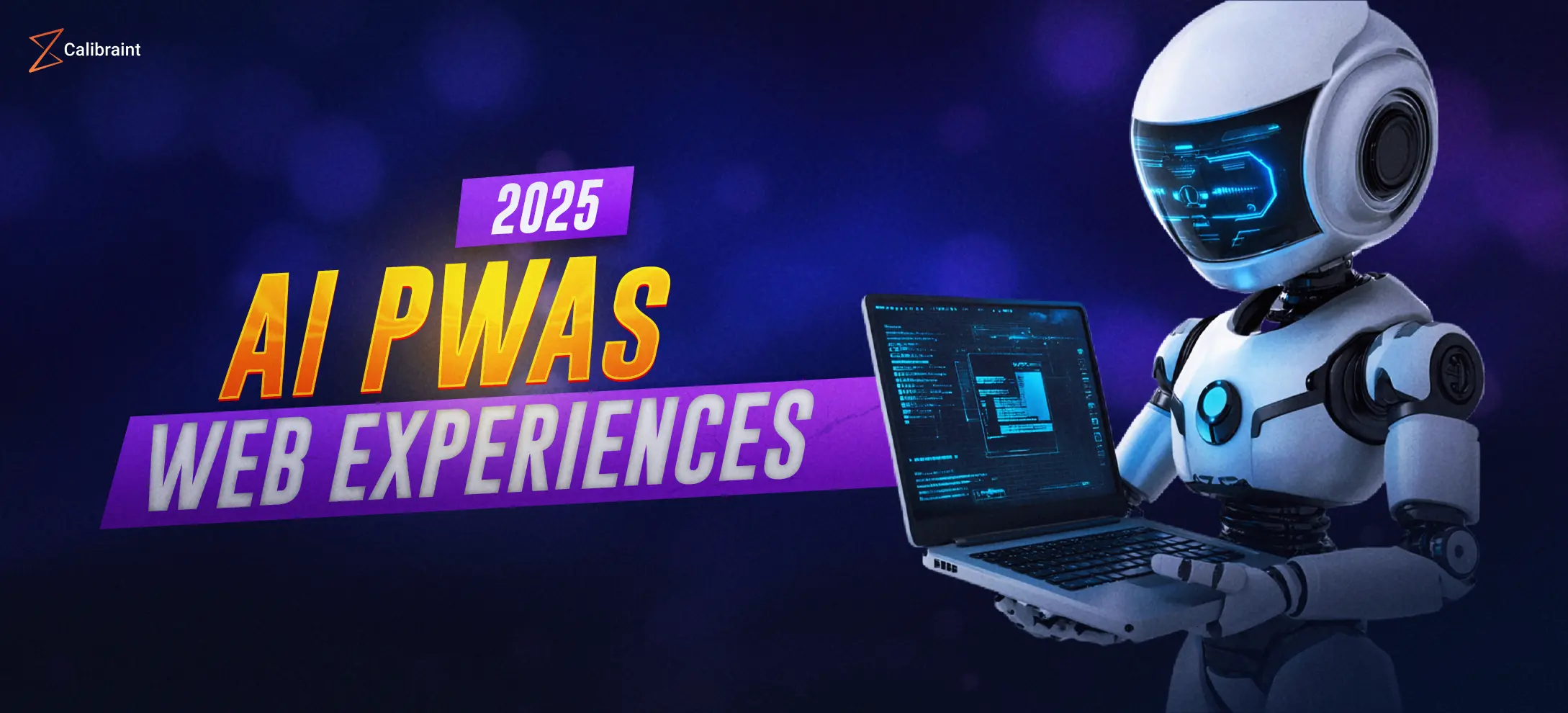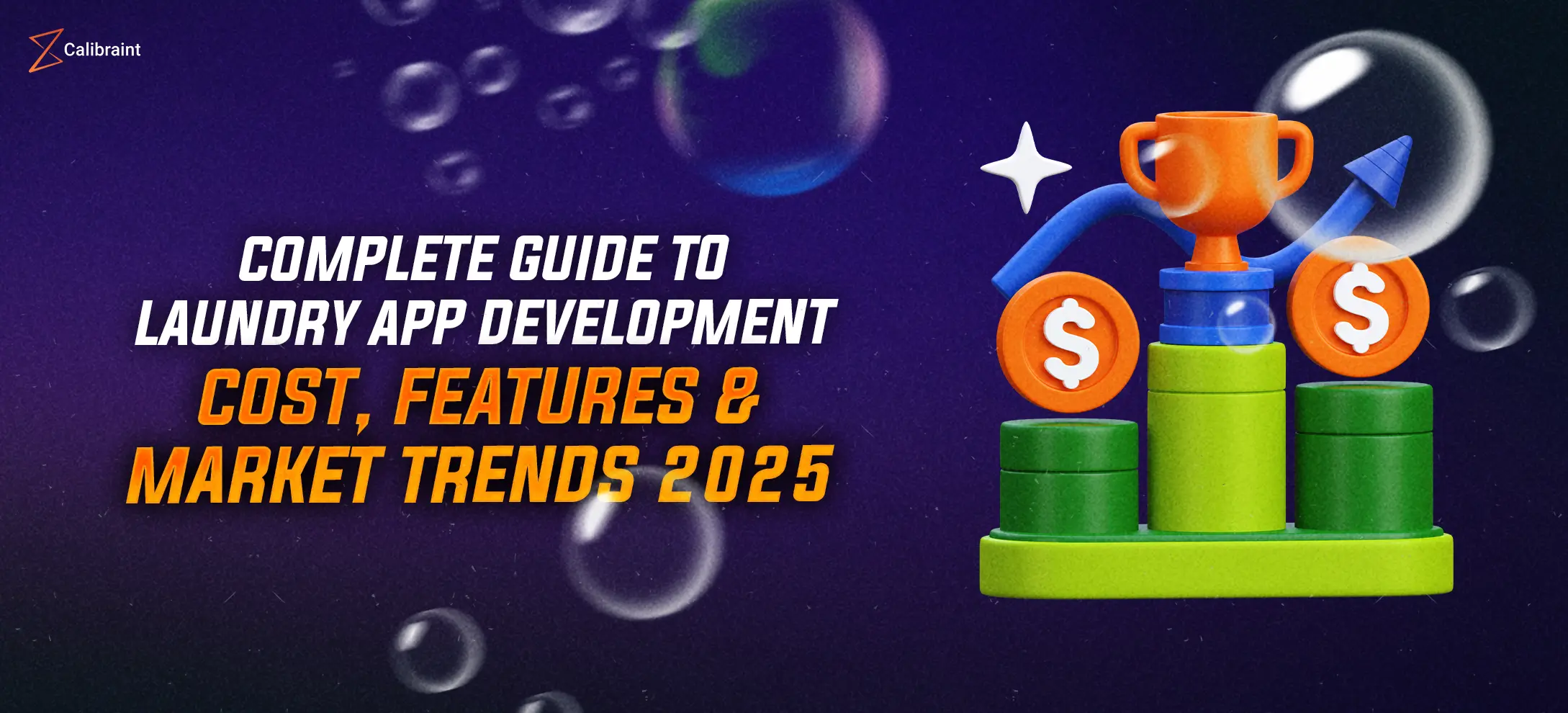Why Is Java Still the King Maker in Enterprise Software Development? Java for Enterprise
Calibraint
Author
May 26, 2025
Last updated: May 29, 2025

According to the 2024 JetBrains Developer Ecosystem Survey, more than 65% of backend developers working in enterprise environments continue to use Java for Enterprise as their primary programming language. Similarly, the 2024 Stack Overflow Developer Survey places Java among the top five most used technologies in large-scale enterprise systems. These findings underscore Java’s continued relevance and reliability in powering mission-critical software across industries.
Over the decades, Java has become synonymous with large-scale, robust, and reliable systems. Yet in 2025, a common question still surfaces: Is Java still used in enterprise environments? The answer is a resounding yes—and this blog aims to unpack exactly why.
For Project Managers, Product Owners, CTOs, CIOs, and even those just entering the field, understanding Java’s enduring relevance can offer insights into more than just code. It speaks to strategic planning, scalability, long-term support, and competitive edge in software development.
How Java Became the Backbone of Global Enterprises
Across industries and continents, Java has quietly powered the digital transformation of the modern world. From complex banking infrastructures and global retail systems to real-time telecommunications networks, Java for a software has cemented its role as the invisible engine driving mission-critical operations.
When Java was introduced in the mid-1990s, its groundbreaking promise—“Write Once, Run Anywhere”—was more than a catchy slogan. It was a paradigm shift. For the first time, developers could build applications that were truly platform-independent, reducing the overhead of rewriting code for different environments. This portability quickly made Java the language of choice for enterprise-scale systems that required reliability, scalability, and long-term viability.
Decades later, this legacy continues. Giants like Amazon, Google, Netflix, and countless Fortune 500 companies still lean heavily on Java to run services that millions use daily. And it’s not just about legacy support—it’s about trust. Java has evolved with the times, incorporating modern features and frameworks that keep it relevant in cloud-native, microservices-driven architectures.
So why has Java endured when trendier languages have come and gone?
Because enterprise software isn’t about hype—it’s about longevity, security, performance, and community. And Java delivers all of that in abundance.
Why Use Java in 2025?
Let’s begin with a seemingly basic but vital question: Why use Java when so many alternatives exist?
1. Stability and Reliability
Java is mature and thoroughly tested. When you’re building systems that need 99.999% uptime, like banking or healthcare software, stability isn’t a luxury—it’s a necessity. Java’s long-standing presence in mission-critical systems is a testament to its robust architecture and dependable nature.
2. Strong Community and Vendor Support
Oracle’s continuous investment in Java, along with a vibrant open-source community, ensures constant innovation without sacrificing stability. Enterprise developers have access to comprehensive documentation, active forums, and professional support. This makes Java not only a technical decision but also a risk-mitigating one.
3. Enterprise-Grade Tooling
It offers an extensive ecosystem of IDEs, performance profilers, CI/CD integrations, and enterprise-grade frameworks like Spring, Hibernate, and Jakarta EE—specifically tailored for scalable enterprise solutions.
4. Long-Term Support and Compatibility
Java’s commitment to backward compatibility ensures that enterprise systems built years ago can still function and evolve with minimal rework. This longevity is vital for enterprises that invest heavily in long-term solutions.
Enterprise Architecture Benefits with Java
When compared to newer languages, Java for enterprise still dominates due to its modular and layered architecture. This enables:
- Clean separation of concerns
- Easier testing and maintenance
- Scalability in distributed systems
These attributes are essential for enterprise software, which demands maintainability and efficiency over long life cycles. It consistently proves its mettle through modularity and ease of debugging, giving large teams the tools they need to develop in parallel and integrate with minimal friction.
Is Java Still Used in Enterprise Development?
Despite the hype around newer programming paradigms, Java is still extensively used across industries.
- Banking & Finance: Almost every major global bank relies on Java for core infrastructure. Its reliability and transaction management make it ideal for secure, real-time financial systems.
- Retail: Giants like Amazon began with Java and continue using it for core functionalities. It powers backend services that ensure consistent performance during peak loads.
- Healthcare & Government: These sectors demand strict data privacy and secure communications. Java’s security architecture helps meet compliance needs effectively.
- Telecom & Utilities: Applications requiring high concurrency and real-time response turn to Java. JVM-level optimizations handle millions of requests seamlessly.
According to a 2024 survey by JetBrains, over 65% of enterprise back-end developers still use Java as their primary language. This is a clear indicator that its relevance isn’t fading anytime soon.
Why Is Java So Popular in Enterprise Software?
Another common query is, why is Java so popular? The reasons are as practical as they are powerful:
- Backward Compatibility: Java applications built a decade ago can still run on today’s JVMs without modification. This protects enterprise investments and reduces the cost of migration. It also enables long-term support strategies for legacy systems.
- Platform Independence: With JVMs available across platforms, Java offers unmatched deployment flexibility. Enterprises can build once and run anywhere—whether on Linux servers, Windows machines, or even cloud-native containers.
- Performance: Java’s Just-In-Time (JIT) compiler and runtime optimization ensure high throughput. This makes it suitable for real-time systems where performance and responsiveness are crucial.
- Security: Java includes robust security measures like bytecode verification and runtime checks. Combined with a mature security API, it’s a natural fit for sensitive enterprise applications and compliance-heavy industries.
- Versatility: From web to mobile and embedded systems, Java handles it all consistently. Its adaptability across domains reduces tech stack fragmentation and boosts development efficiency.
A Cost-Efficient Decision for CIOs and IT Leaders
For CIOs and IT decision-makers, the business case for Java goes beyond technical advantages.
- Reduced Total Cost of Ownership (TCO): Its extensive libraries and pre-built modules shorten development time, resulting in a faster time-to-market.
- Skilled Workforce Availability: With millions of Java developers worldwide, scaling a project or replacing resources is never a bottleneck.
- Third-Party Integrations: It offers seamless integration with legacy systems, databases, cloud services, and third-party APIs—crucial for digital transformation strategies.
- Long-Term Viability: With LTS (Long-Term Support) versions and decades of vendor backing, Java is a long-haul technology, not a fleeting trend.
Java for Enterprise in Cloud, Microservices & DevOps
Enterprise environments have evolved. We’re no longer just deploying monolithic apps on on-prem servers. So how does Java stack up in the era of cloud-native development?
Cloud-Ready with Jakarta EE & Spring Boot
Frameworks like Spring Boot have modernized Java, making it the go-to choice for microservices architecture. Combined with Docker and Kubernetes, Java applications can be easily containerized and orchestrated in cloud environments.
Compatibility with DevOps
Java’s mature build tools like Maven and Gradle, combined with testing frameworks such as JUnit and TestNG, enable high levels of automation in CI/CD pipelines. Java also supports infrastructure-as-code through integrations with tools like Jenkins, Ansible, and Terraform.
Java in Hybrid Cloud Deployments
Java applications are also optimized for hybrid environments. With tools like Open Liberty and Quarkus, developers can create lightweight, startup-fast applications that suit both cloud and edge deployments.
Real-World Use Cases
1. Banking Sector
Major financial institutions like JPMorgan and Citibank run mission-critical applications written in Java. These systems handle millions of transactions per day with unmatched stability and security.
2. Retail & eCommerce
Enterprises like eBay and Walmart use Java-based systems for handling everything from inventory management to payment processing. Java’s performance ensures seamless customer experiences during high-traffic sales seasons.
3. Telecommunications
Java is a top choice for companies needing high-concurrency, low-latency systems capable of handling millions of interactions per second. Its reliability helps telcos maintain uptime and service quality.
4. Manufacturing and Logistics
Enterprise Resource Planning (ERP) and Manufacturing Execution Systems (MES) built with Java offer robust integration with IoT devices, enabling smart factories and real-time monitoring.
Future Outlook: Java for Enterprise Development Roadmap
With new versions released every six months, Java isn’t just surviving—it’s thriving. Recent updates (like Java 21 and beyond) bring features like:
- Pattern Matching
- Record Classes
- Virtual Threads (Project Loom)
- Structured Concurrency
- Foreign Function & Memory API
These enhancements modernize Java, reducing boilerplate code and increasing performance—critical for agile enterprises.
Conclusion:
For those who ask, even in 2025, Java for enterprise continues to power the backbone of mission-critical systems across industries. Its unmatched stability, scalability, and ecosystem make it the go-to choice for future-ready enterprise solutions. Ready to build your next enterprise software with proven technology? Partner with Calibraint and turn Java’s power into your competitive edge.
Calibraint
Author
May 26, 2025
Last updated: May 29, 2025



























